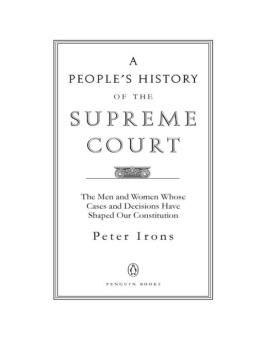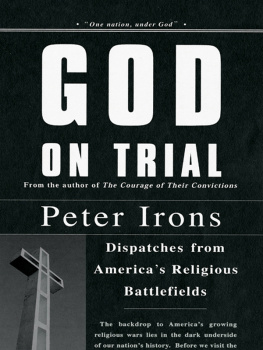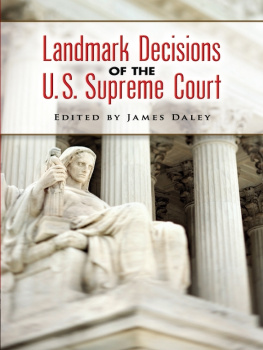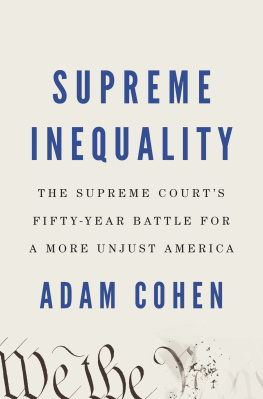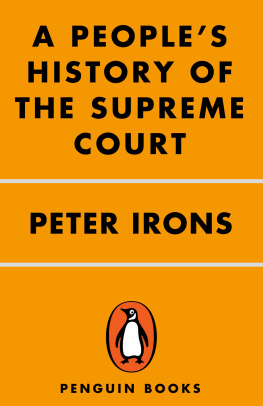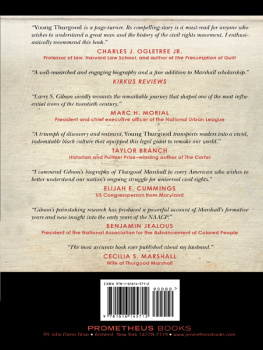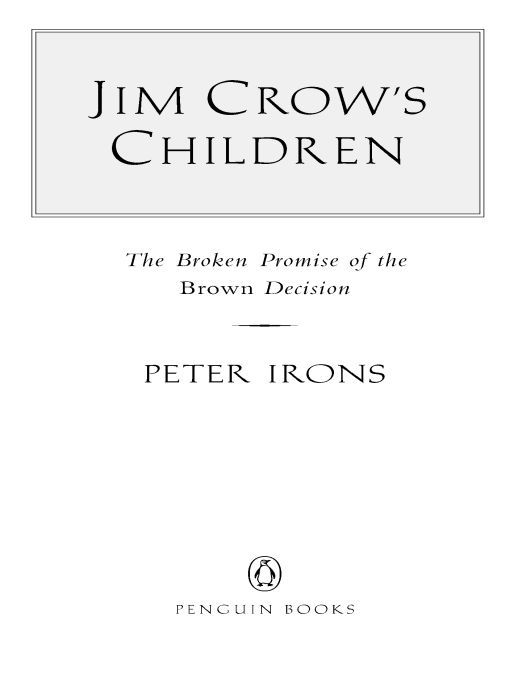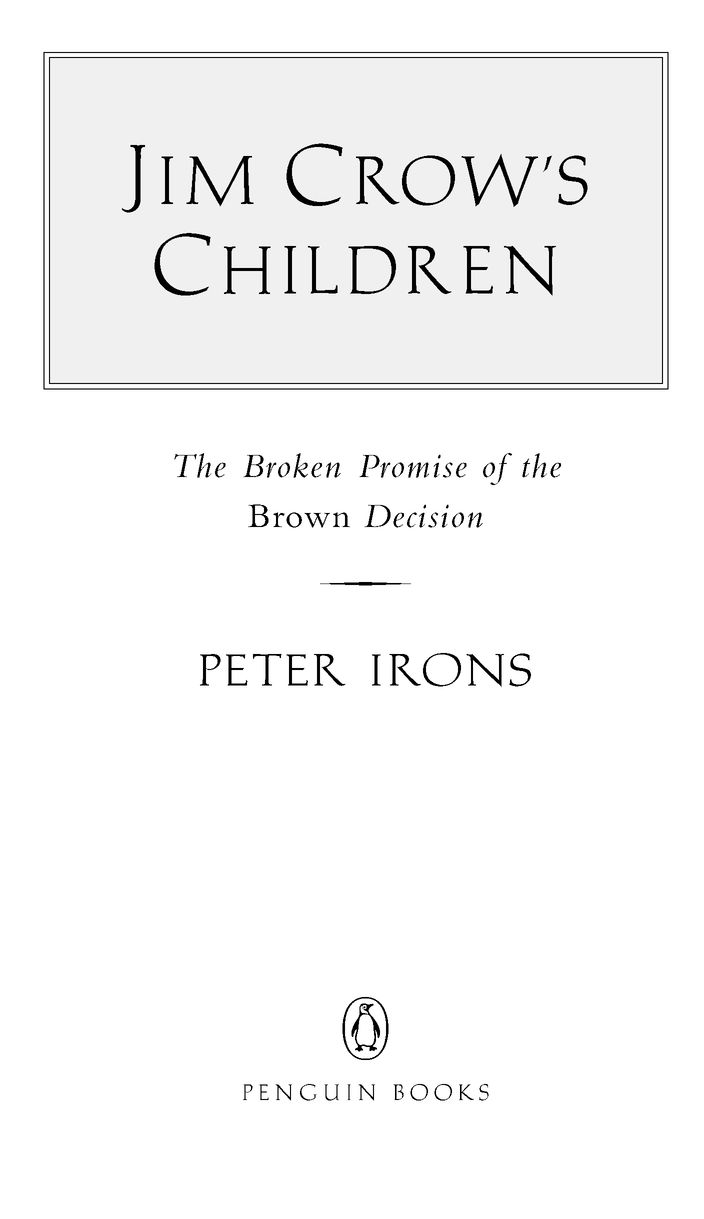Table of Contents
Praise for Peter Ironss Jim Crows Children
Lucid... Irons does an able job of retracing both the long legal crusade that led to the historic decision and its disappointing aftermath... exposing the lingering influences of the past.
The New York Times
An engaging, panoramic history of school desegregation, including the exhilarating breakthroughs and the heartbreaking setbacks. Much has been written about Brown vs. the Board of Education, but Irons provides fresh material by following the stories of the five communities whose lawsuits were part of the effort to dismantle segregation.
The Washington Post
A superbly researched, narratively powerful history of school desegregation in the United States, including an examination of the situation today.The Denver Post
Irons does a wonderful job of evoking the strutting lawyers, the courtroom jousting and the political maneuvering that culminated in the Brown decision.... The dramatic center of the book, though, comes through the stories of ordinary black people who chose to fight segregated schools. Many were forced to flee their communities and were driven into financial ruin because they wanted a decent education for their kids.
The Atlanta Journal-Constitution
A significant number of books have been written about the Brown decision. Few, however, explain as Irons does the politics of massive resistance to court-mandated integration that characterized the South and most of the North after 1954.
The Seattle Times
A calm and steady writer... [Irons] takes his readers easily through the relevant court decisions and brings to life the lawyers who argued them.... His villains are not so much people... but the very manifestations of Jim Crow itself.
Los Angeles Times
Compelling... A respected and influential legal historian, Irons presents the liberal-activist historical argument for integrated primary schoolinga bottom-line moral imperative, to be asserted and sustained through increased judicial involvementabout as well as it can be made.... Irons presents each story cleanly, with a compassion and a brevity that dignifies the suit in question, yet efficiently enough not to lose the narrative thread.The Village Voice
[A] damning indictment of retreat and racism... Avowed integrationist Irons powerfully summarizes Brown vs. Board of Education of Topeka and argues compellingly that subsequent court cases have effected resegregation and the resurrection of Jim Crow.... A book of sorrowsand of surpassing importance. Kirkus Reviews (starred)
PENGUIN BOOKS
JIM CROWS CHILDREN
Peter Irons is professor of political science and director of the Earl Warren Bill of Rights Project at the University of California, San Diego. A graduate of Harvard Law School, Irons is well known in the field as a civil rights lawyer and scholar. His award-winning books include Justice at War and The Courage of Their Convictions and the audio collection May It Please the Court. The most recent, A Peoples History of the Supreme Court, was awarded the Silver Gavel Certificate of Merit by the American Bar Association. He lives in San Diego, California.
FOR BONNIE, who knows that teaching begins with love and respect
PREFACE
Where Are the Buttonwood Kids?
The story of the legal crusade to abolish Jim Crow schooling in America covers most of the nations history, and has not yet ended. This book recounts that campaign, beginning in 1849 with a lawsuit filed in Boston by Benjamin Roberts, after his five-year-old daughter, Sarah, was turned away from the primary school nearest her home on the ground of her being a colored person. This first challenge to racial segregation in public schools ended in defeat, as the Massachusetts Supreme Judicial Court ruled that Sarahs interests will best be promoted by forcing her to attend a Jim Crow school. The last case discussed in these pages also ended in defeat for Kalima Jenkins and other black children in Kansas City, Missouri. Ruling in 1995, the United States Supreme Court terminated judicial oversight of a resegregated school district in which the vast majority of students were black and conditions so bad that one school principal stated that he would not send his own child to that facility.
In between the stories of Sarah Roberts and Kalima Jenkins are those of many other black children whose parents joined legal challenges to Jim Crow schools in more than half of the states, across the country from Massachusetts to California. Most of these children remain unknown, their names unrecorded in the history books that students are assigned to read. The only child whose name is now recalled, Linda Carol Brown of Topeka, Kansas, was in third grade when civil rights lawyers placed her fathers name first on a suit against the citys practice of segregating its elementary schools. One of five similar cases decided by the Supreme Court in 1954, Brown v. Board of Education was hailed by many Americans as a firm judicial statement of the nations commitment to racial equality.
This book recounts the stories of the five cases that produced the Brown decision. We meet the black parents who risked losing their jobs, farms, or homes to join lawsuits against the Jim Crow schools their children were forced to attend. We listen to the lawyers who argued these cases on both sides, attacking and defending school segregation. We sit in the courtrooms of the lower-court judges who first decided these cases, and in the marble-columned chamber of the Supreme Court justices who had the final word in their opinions. And we hear the reactions of politicians, from the states and the Congress to the White House, who praise and denounce the judicial decisions that have shaped and reshaped our nations schools over the past half-century.
The central figure in these stories is Thurgood Marshall, the tenacious, brilliant lawyer who headed the legal staff of the National Association for the Advancement of Colored People between 1938 and 1961. Marshall argued and won more civil rights cases before the Supreme Court than any other lawyer, and played a major role in shaping civil rights law as a Supreme Court justice, serving from 1967 until his retirement in 1991. It was Marshall who developed the legal strategy that attacked the separate but equal doctrine of the Plessy case, which stood as precedent in segregation cases since its decision in 1896. Marshall adopted the military tactics of encirclement and attrition in launching the campaign against Jim Crow schooling, first winning Supreme Court orders that graduate and law schools in border states must admit black students, although the justices declined in these cases to overturn the Plessy decision. After these skirmishes, Marshall picked the target for the first assault on public school segregation in the Deep South. Clarendon County, South Carolina, was a rural area in which blacks outnumbered whites three to one but held no public offices. Many black children walked miles on dirt roads to schools in pinewood shacks with no desks or blackboards, while the countys white children rode buses to spacious brick schools with modern facilities. Marshall selected Clarendon County because its Jim Crow schools made a mockery of the separate but equal doctrine.


